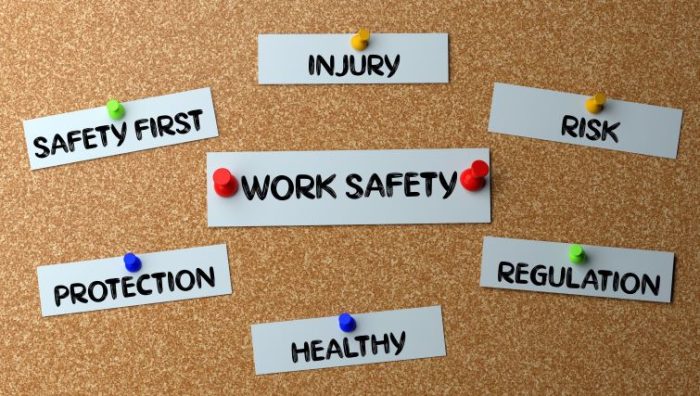How HR Can Help Improve and Maintain Workplace Safety
 Publié le 8 May 2024
Publié le 8 May 2024
Build a better work environment for everyone by knowing how HR can help improve and maintain workplace safety.
Safety is a priority for most companies. In many positions, particularly in healthcare and hospitality, a company’s safety record is key to securing and keeping good employees. A strong safety record and sound safety policies and procedures also save money by avoiding costly injuries, treating complex disabilities, and lost work time. Maintaining a safe workplace is also simply the right thing to do, for employees and clients alike.
One very effective way of improving the safety posture of an organization is to use human resources (HR) to promote, implement, and manage safety policies, procedures, and protocols.
Here is how your HR team can help improve and maintain workplace safety, saving everyone time and money while reducing the stress of employees and management.
Getting Management on Board
Securing support from management for safety programs, policies, and procedures is an often-overlooked aspect of HR but one of the most critical. If management is not on board with the safety message, policies or procedures, it sends an unfortunate message to employees that safety, while important, is not a priority.
HR trends can play a crucial role in helping management grasp the significance of workplace safety. This can be achieved by examining the company’s historical costs related to injuries or illnesses, comparing industry safety incident averages and associated costs, and understanding the immediate as well as long-term repercussions of workplace injuries or illnesses on the lives of well-being of employees.
For example, if an employee is injured on the job and misses work, the manager must find a replacement to sustain the same level of productivity. If the injury is severe and a new employee is hired, the company must foot training costs. If the injury or illness is long-term or the result of negligence, lawsuits for medical costs and damages are possible. Not to mention the potentially devastating effects for the injured employee.
Your HR team can serve as a powerful consensus builder of safety policies and procedures among your management team. Getting management on board will improve employee enthusiasm for safety programs, increase compliance and decrease risks and injuries.
Training New and Existing Employees
Even in smaller companies, HR personnel oversee onboarding. In many cases, the HR team is the de facto “teacher” of the classroom component of any training program, including those covering workplace safety. While managers might walk employees through the practical application of policies, learning the fundamentals and goals of a safety policy in many situations is better served in a classroom environment.
Additionally, the opportunity to acclimate employees to a safe environment is best served during the onboarding process. Starting employees in this environment immerses them in an organization’s safety policies from the start, which increases the likelihood they will comply.
Tracking Training
For existing employees, retraining or refresher training usually are administered by HR, which is a great opportunity to introduce safety policies and reinforce policies and procedures about existing safety programs. The retraining environment allows employees to provide feedback to hone programs and policies to meet real-world demands.
Knowing who needs training or retraining is a role of HR in the form of tracking all completed training for employees. HR keeps tabs on needed training, per employee and safety protocol, and can implement schedules to ensure all employees complete required training on time. HR personnel can also track safety violations and modify training strategies to address them.
Outlet for Concerns
The HR department also protects employees when they want to lodge a complaint or concern regarding workplace safety. When a complaint or concern is made known, HR will handle any investigation and oversee modifications to address anything found to be reasonable. Any employee that lodges a complaint or concern gets legal protection from retribution.
HR handling complaints or concerns works with safety programs because it provides a conduit for employees to report safety violations anonymously without fear of reprisal. That can be a correcting influence and a deterrent to violating safety standards and rules. In this sense, the reporting function of HR serves as a check on safety procedures not being taken seriously.
Identifying Shortfalls
Another role HR plays is in helping to identify safety needs. Identifying safety needs can be done by inspections, personal observation, regulatory requirements, and reports from employees. A robust HR department can take all four sources and formulate a training strategy and implementation schedule that ensures any shortfalls are addressed.
An HR department is the best department to handle this because of three of its core functions:
- Legal compliance
- Personnel programs administration
- Company representative on personnel matters
Those functions provide a perfect environment for HR safety program management.
Encouraging Personnel Wellness
Unhealthy employees tend to create work issues by missing or not completing the required work. These employees also often create an environment where injuries or illnesses can be created. An inebriated employee operating a forklift, for example, is a menace to property, personnel, and themselves.
An active HR program works for employee wellness to promote the healthiest workplace possible. Promoting health can be as simple as distributing health-oriented materials to employees, more complex in the form of official meetings with employees to promote safety program adherence, or extremely involved in actively working with personnel to promote their wellness.
Using the previous forklift example, if that employee is a dependable, skilled resource for the business ordinarily and showing up for work and operating heavy machinery while drunk is an aberration to an otherwise good record, the next steps with that employee might vary. HR might meet with the employee and their boss and find out if anything is amiss with the employee at work or home.
HR personnel might recommend interventionist actions such as helping the employee get counseling or putting the employee on leave until they address what is leading to their behavior. Once the employee has returned to regular status as an employee, HR personnel might keep tabs on the employee’s progress to avoid any further incidents.
For employees that work alone, personal safety and mental health can be major concerns. Lone workers experience violence at alarming rates compared to other employees. Utilizing technology such as a wireless panic button system can help prevent dangerous situations, reduce stress and anxiety, and reduce costs all at the same time.
The ways HR departments can help with workplace safety are expansive. Because of its central role, an HR department can provide comprehensive safety management and training. By understanding how HR can help improve and maintain workplace safety using all the safety resources HR has at its figurative fingertips, there is no reason a company cannot be compliant with all safety programs and regulations.







